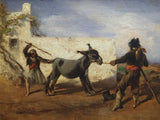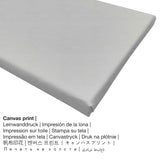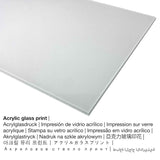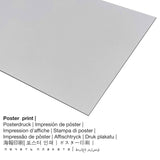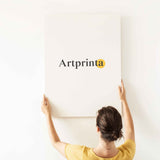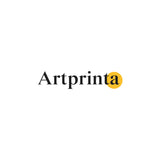Anton Romako, 1856 - L'asino testardo - stampa d'arte
Tasse incluse. Spedizione calcolata alla cassa.
I arte moderna pezzo d'arte The stubborn donkey was made by the historicist artist Anton Romako. The original version measures the size 26 x 34 cm - frame dimensions: 33 x 47 x 6 cm. Olio su tela was applied by the European artist as the technique for the piece of art. Today, the artpiece forms part of the digital art collection of Belvedere in Vienna, Austria. This public domain masterpiece is included, courtesy of © Belvedere, Vienna, numero di inventario: 1959. : dedication Hermione Eissler, Vienna in 1918. Inoltre, l'allineamento della riproduzione digitale è paesaggio e ha un rapporto di 4: 3, which means that the length is 33% longer than the width. The painter Anton Romako was an artist from Austria, whose artistic style can primarily be classified as Historicism. The artist was born in the year 1832 a Vienna, nello stato di Vienna, in Austria e morì all'età di 57 anni nel 1889.
Seleziona il materiale del tuo articolo preferito
Offriamo una gamma di materiali e dimensioni differenti per ogni prodotto. Scegli ora tra le seguenti opzioni di prodotto per soddisfare le tue preferenze in termini di dimensioni e materiale:
- Tela: A UV printed canvas material mounted on a wood frame. The advantage of canvas prints is that they are relatively low in weight, which means that it is easy and straightforward to hang up your Canvas print without extra wall-mounts. A canvas print is suited for any kind of wall.
- Manifesto (materiale tela): The poster is a printed sheet of canvas with a nice texture on the surface. It is particularly suited for placing your art replica with the help of a custom-made frame. Please bear in mind, that depending on the absolute size of the canvas poster print we add a white margin 2-6cm around the print motif to facilitate the framing with a custom frame.
- Metallo (stampa dibond alluminio): Aluminium Dibond prints are prints on metal with a true depth effect. The Aluminium Dibond Print is the perfect start to replicas with aluminum. The white & bright sections of the original artpiece shine with a silk gloss but without any glare.
- La stampa su vetro acrilico (con rivestimento in vero vetro sulla parte superiore): A glossy print on acrylic glass, which is often labelled as a an art print on plexiglass, will turn your favorite original into décor. Beyond that, it is a viable alternative to aluminium and canvas art prints. With an acrylic glass fine art print contrasts and details become recognizeable thanks to the very fine tonal gradation of the print.
Important legal note: We try what we can in order to describe the art products as exact as possible and to exhibit them visually on the product detail pages. At the same time, the pigments of the printing material and the printing might differ slightly from the presentation on your screen. Depending on the screen settings and the quality of the surface, not all colors are printed 100% realistically. Because the fine art prints are processed and printed by hand, there may also be minor discrepancies in the exact position and the size of the motif.
Dettagli strutturati del prodotto
| Classificazione degli articoli: | Wall Art |
| Riproduzione: | riproduzione digitale |
| Metodo di fabbricazione: | stampa digitale |
| Origine del prodotto: | fabbricato in Germania |
| Tipo di scorta: | su richiesta |
| Utilizzo previsto del prodotto: | arte della parete, design per la casa |
| Orientamento dell'immagine: | formato orizzontale |
| Proporzioni dell'immagine: | 4: 3 lunghezza alla larghezza |
| Implicazione delle proporzioni: | la lunghezza è del 33% più lunga della larghezza |
| Materiali disponibili per il prodotto: | stampa su tela, stampa su metallo (dibond di alluminio), stampa su vetro acrilico (con rivestimento in vero vetro), stampa su poster (carta tela) |
| Opzioni dimensioni tela su telaio barella (stampa su tela): | 40 x 30 cm - 16 x 12 ", 80 x 60 cm - 31 x 24", 120 x 90 cm - 47 x 35 ", 160 x 120 cm - 63 x 47 pollici |
| Stampa su vetro acrilico (con rivestimento in vero vetro): | 40 x 30 cm - 16 x 12 ", 80 x 60 cm - 31 x 24", 120 x 90 cm - 47 x 35 " |
| Varianti di stampa poster (carta tela): | 40 x 30 cm - 16 x 12 ", 80 x 60 cm - 31 x 24", 120 x 90 cm - 47 x 35 " |
| Dimensioni di stampa dibond in alluminio: | 40 x 30 cm - 16 x 12 ", 80 x 60 cm - 31 x 24", 120 x 90 cm - 47 x 35 " |
| Struttura: | Senza cornice |
Tavolo strutturato dell'opera d'arte
| Titolo dell'opera: | "The stubborn donkey" |
| Classificazione delle opere d'arte: | pittura |
| Termine dell'ombrello: | arte moderna |
| Classificazione temporale: | 19th secolo |
| Creato nell'anno: | 1856 |
| Età dell'opera d'arte: | oltre 160 anni |
| Mezzo di opera d'arte originale: | olio su tela |
| Dimensioni dell'opera d'arte originale: | 26 x 34 cm - dimensioni cornice: 33 x 47 x 6 cm |
| Museo / collezione: | Belvedere |
| Ubicazione del museo: | Vienna, Austria |
| Sito del museo: | www.belvedere.at |
| Licenza: | dominio pubblico |
| Per gentile concessione di: | © Belvedere, Vienna, numero di inventario: 1959 |
| Linea di credito dell'opera d'arte: | dedication Hermione Eissler, Vienna in 1918 |
Breve panoramica dell'artista
| Nome dell'artista: | Anton Romako |
| Conosciuto anche come: | romako a., a. romako, romako anton, Romako, Romako Anton, Anton Romako |
| Genere dell'artista: | maschio |
| Nazionalità dell'artista: | austriaco |
| Lavori dell'artista: | pittore |
| Paese dell'artista: | Austria |
| Categoria dell'artista: | artista moderno |
| Stili d'arte: | Storicismo |
| Durata: | 57 anni |
| Anno di nascita: | 1832 |
| Luogo di nascita: | Vienna, stato di Vienna, Austria |
| Anno di morte: | 1889 |
| Posto di morte: | Vienna, stato di Vienna, Austria |
© Copyright - Artprinta (www.artprinta.com)
Descrizione dell'opera originale dal sito web di Belvedere (© - di Belvedere - Belvedere)
The oil painting The stubborn donkey Anton Romako was probably in 1856 during a trip to Spain by the artist and is considered the earliest surviving genre painting in his oeuvre. The contrast, saturated colors of humorous scene corresponds to the intense light of the South. The loose and sketchy brushwork acting like about works by Francisco de Goya or El Greco remember and is probably due Romako encounter with original works of Spanish painting tradition. 1860 gained Romako in Rome primarily oriented on the art market landscape views, genre paintings and portraits large financial and social recognition. After a failed marriage to the artist in 1875 returned to Vienna, where his style but not met the prevailing taste. With his increasingly bizarre and excessive design language and the emphasis on psychological moments he took elements of early expressionism anticipated. lonely in his later years and impoverished, was Romako an outsider among the historicist painters that should be rediscovered by future generations as an important reference point. [Kerstin Krenn, in: Agnes Husslein, Severin Dünser, Luisa Ziaja (ed.), Flirting with Strangers. Encounters with works from the collection, Vienna 2015, p 106.]

